Know your chopper: part one
Regular readers may have noticed that an increasing n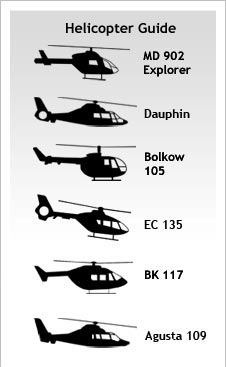 umber of call-outs now involve the use of an air-ambulance. The speed and manoeuverability of these aircraft has made a dramatic difference to the time in which a casualty can receive treatment and be transported to hospital care. In years gone by it was only the severest of injuries which would justify the calling of a helicopter and that would mean bringing a RAF search & rescue helicopter from Leconfield in North Yorkshire.
umber of call-outs now involve the use of an air-ambulance. The speed and manoeuverability of these aircraft has made a dramatic difference to the time in which a casualty can receive treatment and be transported to hospital care. In years gone by it was only the severest of injuries which would justify the calling of a helicopter and that would mean bringing a RAF search & rescue helicopter from Leconfield in North Yorkshire.
Now the smaller air-ambulance helicopters are scrambled for nearly every remote incident and are often overhead before the mountain rescue teams have assembled. So where do these aircraft come from, who pays for them and is there still a nead for mountain rescue teams?
Depending on the location normally one of five air-ambulance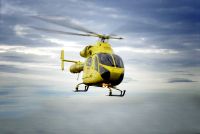 s can be scrambled to assist with an incident in the Peak District. Like all the 30 aircraft available throughout England & Wales our local five are run by charities and depend on donations to keep them flying. The pilots are full time employees, usually ex-military, but the paramedic or doctor aircrew are usually seconded from the local ambulance trust. Each aircraft is tasked by the local NHS Ambulance Control Room which sifts 999 calls to select appropriate incidents. 40% of their missions will be to road accidents but the remoteness of much of the Peak District National Park and the crowed roads means they are tasked to n
s can be scrambled to assist with an incident in the Peak District. Like all the 30 aircraft available throughout England & Wales our local five are run by charities and depend on donations to keep them flying. The pilots are full time employees, usually ex-military, but the paramedic or doctor aircrew are usually seconded from the local ambulance trust. Each aircraft is tasked by the local NHS Ambulance Control Room which sifts 999 calls to select appropriate incidents. 40% of their missions will be to road accidents but the remoteness of much of the Peak District National Park and the crowed roads means they are tasked to n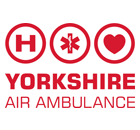 early every off road incident in the area. Most of the helicopters can be off the ground within 2 minutes of a call and are just 10 – 15 minutes flying time from the centre of the Peak. Each will have a pilot and 2 medics on board and can remain airborne for between 2 -4 hours. All the regularly used receiving accident and emergency hospitals are just another 10 minutes away.
early every off road incident in the area. Most of the helicopters can be off the ground within 2 minutes of a call and are just 10 – 15 minutes flying time from the centre of the Peak. Each will have a pilot and 2 medics on board and can remain airborne for between 2 -4 hours. All the regularly used receiving accident and emergency hospitals are just another 10 minutes away.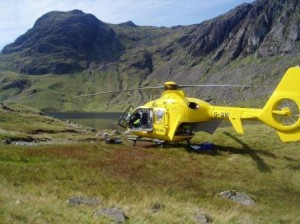
A regular visitor is the Yorkshire Air-ambulance flying out of Sheffield City Heliport. Using a MD 902 aircraft its patch will include the Upper Derwent Valley.
Providing “Care From The Air” in the north of the Peak is the North West Air-ambulance established in 1999 to cover Cumbria, Cheshire, Lancashire & Greater Manchester and flies from Blackpool Airport. The EC 135 T2 helicopters have twin engines and provide a smooth ride for casualties.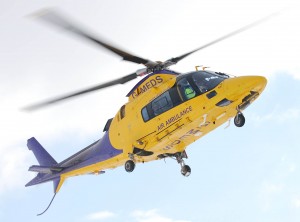
The aircraft that Buxton Team has most dealings with is the Agusta 109 Derbyshire, Leicester & Rutland Air-ambulance flying from East Midlands Airport at Kegworth. The distinctive yellow cabin with blue tail has been a familiar sight since the service was established in April 2008 and the aircraft always carries a doctor as part of the crew.
Althoug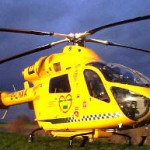 h Derbyshire is not strictly within its operational area, the MD 902 Lincolnshire & Nottinghamshire Air-ambulance is a frequent visitor and worked with the team recently in Monsal Dale. This aircraft flies from RAF Waddington just south of Lincoln and operates up to 12 hours a day through the summer months.
h Derbyshire is not strictly within its operational area, the MD 902 Lincolnshire & Nottinghamshire Air-ambulance is a frequent visitor and worked with the team recently in Monsal Dale. This aircraft flies from RAF Waddington just south of Lincoln and operates up to 12 hours a day through the summer months.
Covering a more westerly area in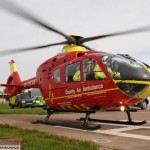 cluding the Staffordshire Moorlands is the bright red Euro 135 Midlands Air-ambulance, formerly known as the Three Counties Air-ambulance. In 2008/9 this aircraft attended 8 climbing accidents mostly at The Roaches and Hen Cloud.
cluding the Staffordshire Moorlands is the bright red Euro 135 Midlands Air-ambulance, formerly known as the Three Counties Air-ambulance. In 2008/9 this aircraft attended 8 climbing accidents mostly at The Roaches and Hen Cloud.
If you were thinking of buying a helicopter you should know that national statistics show that each air-ambulance mission costs an average of £1,229, and will consume 130 litres of fuel!
So, with all these aircraft in the sky, is there still a place for mountain rescue?
Whilst an air-ambulance is a fantastic tool and has revolutionised the speed at which a casualty can reach hospital it does have its limitations. Air-ambulances can only operate in daylight as the costs leasing the aircraft for night flying are prohibitive. Visibility and poor weather conditions also limit the aircraft’s ability to fly. Landing can also be a problem despite some recent quite remarkable displays of piloting notably in Chee Dale. Often the patient has to be carried some distance by stretcher from the accident site to the landing site requiring 8-10 people with the necessary casualty handling skills. Currently none of the air-ambulances have any winching capability so all casualties have to be loaded through the door whilst the aircraft is on the ground. And finally, we have to consider the family, friends and companions of the injured person who can be left on the hillside, confused about what is happening, and sometimes not knowing how to get off.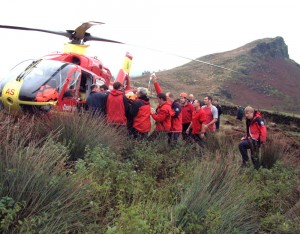
Mountain Rescue has always been a multi-agency task requiring team work and respect for each others skills and resources. Air-ambulances just bring a new and more efficient approach to the old problems of casualties in remote locations. The protocol in the event of an air-ambulance being tasked to a casualty in a remote area still includes calling mountain rescue to provide the man-power and local knowledge to back up the aircrew and complete the task should the need arise. Teams have always looked to modernise their methods and willingly adapt to new technology and working practices. The ultimate aim remains the same; save life and reduce suffering, and this is more easily achieved with training and team-working between all the emergency services.
Helicopters can and do play a very important role but when weather, darkness or availability fail, it will still be the team members who pull on their boots and carry the equipment in the old fashioned way.
Photos top to bottom: Yorkshire Air-ambulance. North West Air-ambulance. Derbyshire, Leicestershire & Rutland Air-ambulance. Lincolnshire & Nottinghamshire Air-ambulance. Midlands Air-ambulance. BMRT members load an injured climber in to the then 3 Counties aircraft at The Roaches, Staffordshire.
None of these aircraft are funded by the NHS and depend on public charitable donations to maintain their service. 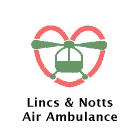 To make a donation to any of the air-ambulance charities visit www.justgiving.com
To make a donation to any of the air-ambulance charities visit www.justgiving.com 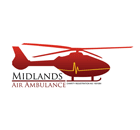 or the individual web-sites.
or the individual web-sites.
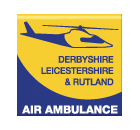
More detailed information is available on the websites of each of the air-ambulance charity trusts and the website of the Association of Air-ambulances UK from which most of this information was gained.
Know Your Chopper Part Two (seakings and police) will appear soon.